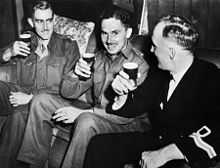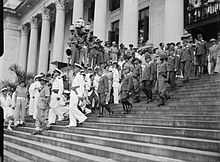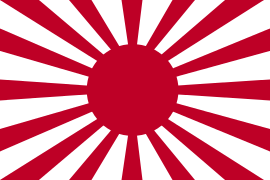Japanese occupation of Singapore
| Japanese-occupied Singapore | ||||||
| Syonanto 昭南島 Shōnantō | ||||||
| Military occupation by the Empire of Japan | ||||||
| ||||||
| ||||||
 | ||||||
| Capital | Singapore | |||||
| Government | Military occupation | |||||
| Historical era | World War II | |||||
| - | Pacific War begins | 8 December 1941a | ||||
| - | Britain surrenders Singapore to Japan | 15 February 1942 | ||||
| - | Allied bombing raids | Nov 1944 – May 1945 | ||||
| - | Surrender of Japan | 15 August 1945 | ||||
| - | Singapore surrendered to British Military Administration | 12 September 1945 | ||||
| - | Singapore becomes a Crown colony | 1 April 1946 | ||||
| Currency | Japanese-issued dollar ("Banana money") | |||||
| Today part of | | |||||
| a. | The Pacific War started on 8 December 1941 in Asian timezones, but is often referred to as starting on 7 December, as that was the date in European and American timezones (such as for the attack on Pearl Harbor in the United States' Territory of Hawaii). | |||||
The Japanese occupation of Singapore in World War II took place from 1942 to 1945, following the fall of the British colony on 15 February 1942. Military forces of the Empire of Japan occupied it after defeating the combined Australian, British, Indian, and Malayan garrison in the Battle of Singapore. The occupation was to become a major turning point in the histories of several nations, including those of Japan, Britain, and the then-colonial state of Singapore. Singapore was renamed Syonan-to (昭南島 Shōnan-tō), meaning "Light of the South".[1][2]
Singapore was officially returned to British colonial rule on 12 September 1945, following the formal signing of the surrender instrument at the Municipal Building.
Events leading to the occupation
The Japanese captured all of Malaya during the Malayan Campaign in little more than two months. The garrison defending Singapore surrendered on 15 February 1942, only a week after the invasion of the island commenced. British Prime Minister Winston Churchill called the fall of Singapore "the worst disaster and largest capitulation in British history".[3]
Life during the occupation
Reign of terror
The Kempeitai (the Japanese military secret police), committed numerous atrocities against the common people. They introduced the system of "Sook Ching", which means "purge through purification" in Chinese, to get rid of those deemed to be anti-Japanese. The Sook Ching Massacre claimed the lives of between 25,000 and 50,000 ethnic Chinese in Singapore and Malaya. These men were rounded up and taken to deserted spots around the island and killed systematically. Moreover, the Kempeitai established a network of informers around the island to help them identify those who resisted. These informers were well-paid by the Kempeitai and had no fear of being arrested. Japanese soldiers patrolled the streets and commoners had to bow to them when they passed by. Those who failed to do so would be slapped or beaten and some people would be taken away.
Other changes in Syonan-to
To remove Western influence, the Japanese set up schools and forced the people to learn their language. Textbooks were printed in Japanese. Every morning, the children had to stand facing the direction of Japan and sing the Japanese national anthem.
In the cinemas, only Japanese movies and propaganda films were shown. These films showed the virtues of the Japanese and made fun of the British. Going to the cinemas at all had its dangers, since the Japanese might suddenly appear and take away young men to work on the Death Railway. Sometimes, they would plant themselves in the cinemas and would listen secretly to conversations, hoping to overhear anti-Japanese remarks.
The local Chinese and English newspapers had very little local news. Most of what was reported was the Japanese version of the war and pro-Japanese speeches. Radio stations were controlled by the Japanese and radio owners could listen only to local broadcasts. Tuning in to foreign broadcasting stations was done at great risk. Those caught doing so were severely punished or even killed.
Scarce basic necessities
.jpg)
Resources were scarce during the occupation. The prices of basic necessities increased drastically due to hyperinflation. For example, the price of rice increased from $5 per 100 catties (about 60 kg or 130 lb) to $5,000. The Japanese issued ration cards to limit the amount of resources received by the civilian population. Adults could purchase 4.8 kg (11 lb) of rice per month and 2.4 kg (5.3 lb) for children. The amount of rice for adults was reduced by 25% as the war progressed.[4]
The Japanese issued banana money as their main currency since Straits currency became rare. They instituted elements of a command economy in which there were restrictions on the demand and supply of resources, thus creating a popular black market. The "banana currency" started to suffer from high inflation and dropped drastically in value because the authorities would simply print more whenever they needed it; consequently the black market often used Straits currency.
Food quality and availability decreased greatly. Sweet potatoes and yams became the staple food of most diets of Singaporeans because they were considerably cheaper than rice and could also be grown in gardens. They were then turned into a variety of dishes, as both dessert and all were used in all three meals of the day. The nutrients helped to fend starvation off; new ways of consuming tapioca with other produce were regularly invented to stave off the monotony. Both the British and Japanese authorities encouraged the population to grow their own food if they had even the smallest amount of land. The encouragement and produce were similar to what occurred with victory gardens in the Western nations during World War II.[5] Ipomoea aquatica, which grew relatively easy and flourished relatively well near the water, became a popular crop, as did other vegetables.
Education
After taking Singapore, the Japanese established the Shonan Japanese School (昭南日本学園 Shōnan Nihon Gakuen), to educate the natives in the Japanese language. Faye Yuan Kleeman, the author of Under an Imperial Sun: Japanese Colonial Literature of Taiwan and the South wrote that this was the most successful such school in Southeast Asia.[6] During the occupation, the Japanese had also opened the Shonan First People's School.[7]
Allied attacks

Singapore was the target of various operations masterminded by Allied forces to disrupt Japanese military activities. On 26 September 1943, an Allied commando unit known as Z Force led by Major Ivan Lyon infiltrated Singapore Harbour and sank or damaged seven Japanese ships comprising over 39,000 long tons (40,000 metric tons). Lyon led another operation, codenamed Rimau, with the same objective almost a year later and sank three ships. Lyon and 13 of his men were killed after the Japanese captured them. The other 10 men who participated in the operation were charged with espionage in a kangaroo court and subsequently executed.
Lim Bo Seng of Force 136 led another operation, code-named Gustavus, to establish an espionage network in Malaya and Singapore and gather intelligence about Japanese forces for the Allies. However, Operation Gustavus failed and Lim was captured along with his men. He died in prison due to ill-treatment. Force 136 was eventually disbanded after the war.
In August 1945, two midget submarines of the Royal Navy took part in Operation Struggle, a plan to infiltrate Singapore Harbour and sabotage the Japanese cruisers Takao and Myōkō using limpet mines. They inflicted heavy damage on Takao, earning Lieutenant Ian Edward Fraser the Victoria Cross. From November 1944 to May 1945, Singapore was subjected to air raids by British and American long-range bomber units.
End of the occupation


On 6 and 9 August 1945, two US B-29 bombers called 'Enola Gay' and 'Bockscar', dropped atomic bombs on the Japanese cities of Hiroshima and Nagasaki. On 8 August 1945, the Soviet Union declared war on Japan and invaded Manchuria. The bombing of Hiroshima and Nagasaki along with the entry of the Soviet Union into the war ended the Japanese occupation of Southeast Asia. By then, the Japanese had allowed the Allies to send in forces and food supplies. Prisoners-of-war were checked by medical officers and arrangements were made to send them home.
On 15 August, Japan announced its surrender. The formal signing of the surrender instrument was held at City Hall, Singapore, then known as "Municipal Hall", on 12 September. This was followed by a celebration at the Padang, which included a victory parade. Lord Louis Mountbatten, Supreme Allied Commander of South East Asia Command, came to Singapore to receive the formal surrender of the Japanese forces in the region from General Seishirō Itagaki on behalf of General Hisaichi Terauchi. A British military administration using surrendered Japanese troops as security forces was formed to govern the island until March 1946.
After the Japanese surrendered, there was a state of anomie in Singapore, as the British had not yet arrived to take control. The Japanese occupiers had a considerably weakened hold over the populace. There were widespread incidents of looting and revenge-killing. Much of the infrastructure had been wrecked, including the harbour facilities and electricity, water supply and telephone services. It took four or five years for the economy to return to pre-war levels. When British troops finally arrived they were met with cheering and fanfare.
Banana money became worthless after the occupation ended. Many individuals who had acquired their wealth through banana currency were rendered penniless overnight.
Popular culture
The Japanese occupation of Singapore has been depicted in media and popular culture, including films, television series and book
Films
- (Japanese) Minami Jujisei (The Southern Cross, also known as The Highest Honour and Heroes of the Krait) (1982), a Japanese-Australian co-production.[8][9]
Television series
- (English) Early episodes of Tenko, a BBC/ABC production.
- (English) The Heroes (1988), an Australian-British co-production.
- (English) Heroes II: The Return (1991), an Australian miniseries.
- (Chinese) The Last Rhythm (1996), produced by the Television Corporation of Singapore (TCS).
- (Chinese) The Price of Peace (1997), produced by the TCS.
- (English) A War Diary (2001), produced by MediaCorp.
- (Chinese) In Pursuit of Peace (2001), produced by MediaCorp.
- (English) Changi (2001), produced by the Australian Broadcasting Corporation.
List of monuments and historical sites
- Civilian War Memorial
- Kranji War Memorial and Cemetery
- Changi Chapel and Museum
- YMCA on Orchard Road
- Alexandra Hospital grounds
- Old Ford Motor Factory
See also
- History of Singapore
- Japanese occupation of Malaya
- Japanese occupation of British Borneo
- Japanese occupation of Hong Kong
- Bombing of Singapore (1944–1945)
References
- ↑ Abshire, Jean (2011). The History of Singapore. ABC-CLIO. p. 104. ISBN 031337743X.
- ↑ Blackburn, Kevin; Hack, Karl (2004). Did Singapore Have to Fall?: Churchill and the Impregnable Fortress. Routledge. p. 132. ISBN 0203404408.
- ↑ Churchill, Winston S. Second World War IV. 6 vols, London, 1948–54 p. 81.
- ↑ "Japanese Occupation". AsiaOne. Retrieved 1 May 2006.
- ↑ "Hungry years". AsiaOne. Retrieved 1 May 2006.
- ↑ Kleeman, Faye Yuan. Under an Imperial Sun: Japanese Colonial Literature of Taiwan and the South. University of Hawaii Press, 2003. p. [books.google.com/books?id=CFEyQWoNSJ8C&pg=PA43 43]. ISBN 0824825926, 9780824825928. "The most successful was the Japanese school in Singapore. A month after the British surrendered (February 15, 1942), Japan renamed the island Shonan (literally "illuminating the south") and founded the famous Shonan Japanese School (Shōnan Nihon Gakuen 昭南日本学園)"
- ↑ "A BRIEF HISTORY." (Archive) The Japanese School Singapore. Retrieved on 2 January 2014.
- ↑
- ↑
External links
| Library resources about Japanese occupation of Singapore |
- Fall of Malaya and Singapore, a detailed history of the Battle of Singapore.
| ||||||||||||
| ||||||||||||||||||||||||||
| ||||||||||||||||||||||||||||||||||||||||||||||||||||
| ||||||||||
.svg.png)


.svg.png)